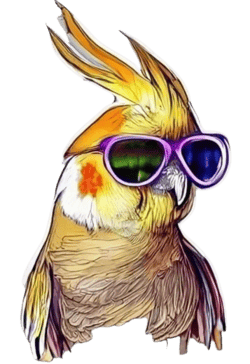How Big is a Cockatiel? Surprising Facts You Never Knew About Your Pet Bird
Well, howdy folks, and bird lovers alike! Let’s delve into the fascinating world of our feathered friends – the ever-charming cockatiels. These charming birds have nestled their way into countless homes, their peppy, curious, and cuddly natures making them an all-time favorite pet.
Pedigree doesn’t matter when it comes to love, but the folks who have a fondness for facts might find solace in knowing a bit more about their chirpy companion. Size? Check! Quirky features? Super check! What, you didn’t think these cuddle bugs were just fluffy balls of feathers, did you?
So, strap on your explorer hats, or maybe just a pot if you can’t find one, as we take a deep dive into the world of cockatiels. Let’s wade our way through some surprising fact-o-nuggets about your pet bird’s size and other fascinating features!
Understanding Cockatiel Size: How Big is a Cockatiel?

Let’s start with some serious stats. An adult cockatiel generally weighs in around 75 to 125 grams, stands up to 30 to 33cm tall, beak to tail – a little longer than your average Bic pen, and has an impressive wingspan of 45cm. That’s almost as long as the short end of your A3 art paper!
Cockatiel sizes can be influenced by various factors. Boys often tend to be a smidge larger than girls, a trend we’ve seen across many species, not just our feathery friends. Age can be a determinant too, as younger cockatiels are understandably smaller. If you’re curious about the visual aspects of these charming birds and want to explore more about what cockatiels look like, check out this detailed guide on CockatielHQ: What Do Cockatiels Look Like?.
Beyond that, subspecies can come into play too. For instance, the White-faced Cockatiel tends to be a smidgen larger than its cockatiel cousins. Mother Nature does love her variety, doesn’t she?
Fascinating Facts on Cockatiel Size Related to Their Environment
Well, buckle up folks. Our chirpy buddies are prime examples of adaptive evolution. Cockatiels weave environmental circumstances into their DNA, and it reflects on their size.
You might find the cockatiels hailing from warmer regions appear larger. It’s theorized that bigger bodies help keep their cool—quite literally! Conversely, cockatiels from cooler regions tend to be smaller, helping them retain their body heat.
Human-made environments count too. Our homes, more specifically, our protective, indulgent care might be causing pet cockatiels to grow larger than their wild counterparts. Oops? But hey, a chubbier cockatiel just means there’s more of them to love!
Cockatiel Size and Its Implications on Their Diet
Let’s talk about the bread and butter now, or maybe pellets and seeds, to be bird accurate. A bigger bird requires a bigger diet, it stands to reason. The daily dietary needs of a cockatiel typically range from 30 to 40 grams of a balanced mix of seeds, pellets, fruits, and vegetables, depending on their size.
Did you know? Surprisingly, certain foods like quinoa and sweet potato might just give your cockatiel a growth spurt! But tread carefully, portion control is key. Overfeeding can transform your cute cockatiel into a chubby Charlie really quickly!
How Cockatiel Size Affects Bird-Human Interaction

Your cockatiel isn’t just another bird. They’re family, and they deserve a space that fits them right. For a cockatiel, a roomy cage that can comfortably accommodate their wingspan is a must-have. They need room to stretch and show off their charming flight.
Size can inadvertently affect their behavior too. Larger cockatiels could appear more assertive, simply due to their dominating stature. They also tend to be more vigorous and lively, which can be quite a joyful experience but can occasionally lead to furniture casualties. Armor your table corners folks!
Size-Related Health Concerns for Your Cockatiel
Big or small, cockatiel health should rank top on your pet care list. Overweight, like for us Homo Sapiens, can be a health risk for these pretty nibs. Arthritis, liver disorders, even heart disease can afflict an overweight cockatiel. Underweight birds aren’t safe from risks either, as it could signify underlying health issues.
A healthy diet, regular vet check-ups, and an active lifestyle can go a long way in maintaining a healthy cockatiel size. Learn more about proper care, handling, and the delightful aspects of cockatiel companionship in this comprehensive guide on Cockatiel HQ’s pillar page: Cockatiel Petting.
Conclusion
Bird-keeping, especially cockatiels, isn’t just a joyful hobby; it can be a learning experience too. Who would have thought that the size of your perky buddy could open up so many interesting avenues? Whether you’re a seasoned birder or a newbie, there’s always something to learn, something to surprise you in the immensely rich and diverse world of cockatiels.
So keep learning, keep loving your pet cockatiel, and remember, the best size for a bird is a happy bird!
Frequently Asked Questions
What’s the average weight of a cockatiel?
Typically, it would be anywhere between 75 to 125 grams.
Do the dietary needs of a cockatiel depend on its size?
Yes, larger cockatiels require more food compared to their smaller counterparts.
Can a cockatiel’s size affect its behavior?
Quite surprisingly, yes. Larger cockatiels may appear more assertive due to their size.
Remember folks, loving a bird isn’t just about feeding it and keeping it safe. It’s about understanding it, knowing its needs and quirks, and making sure your feathered friend stays as chirpy as it can be!

About Me
I’m Kamran, a co-founder and content creator at cockatielhq.com. With 8+ years in the world of avian enthusiasts, I’ve gained extensive knowledge in caring for birds. From egg-laying and mating to cohabitation with other birds, dietary needs, nurturing, and breeding, I’m here at cockatielhq.com to share valuable insights for your avian companions.








One Comment